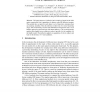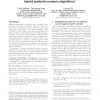7228 search results - page 2 / 1446 » From Algorithmic to Subjective Randomness |
82
Voted
ICASSP
2010
IEEE
14 years 10 months ago
2010
IEEE
A major limitation of Brain-Computer Interfaces (BCI) is their long calibration time, as much data from the user must be collected in order to tune the BCI for this target user. I...
95
Voted
APGV
2004
ACM
15 years 6 months ago
2004
ACM
We introduce the concept of vision-realistic rendering – the computer generation of synthetic images that incorporate the characteristics of a particular individual’s entire o...
94
Voted
MICCAI
2005
Springer
16 years 1 months ago
2005
Springer
This paper proposes a method to infer a high level model of the white matter organization from a population of subjects using MR diffusion imaging. This method takes as input for e...
108
Voted
ISSAC
2007
Springer
15 years 6 months ago
2007
Springer
Algebraic randomization techniques can be applied to hybrid symbolic-numeric algorithms. Here we consider the problem of interpolating a sparse rational function from noisy values...
93
Voted
GECCO
2005
Springer
15 years 6 months ago
2005
Springer
In this work we provide empirical evidence that shows how a variable-length genetic algorithm (GA) can naturally evolve shorter average size populations. This reduction in chromos...


